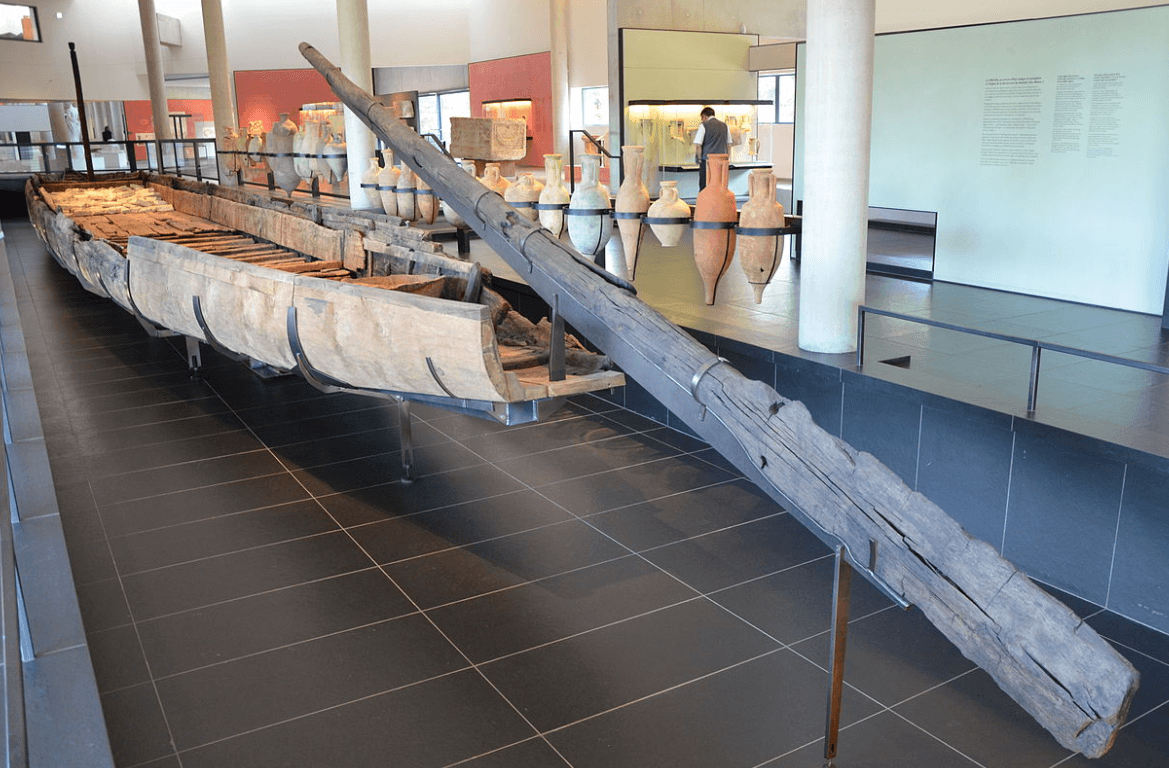River Transport in the Roman Empire: Inland Navigation, Trade, and Engineering
Table of Contents
Natural Highways of the Empire
Roman rivers served as natural highways, carrying food, raw materials, and people across the empire. Rivers like the Tiber, Rhine, and Danube were vital arteries for inland transport.
The Tiber River, for example, brought boatloads of grain and other supplies from the seaport at Ostia upriver to Rome’s warehouses. Large, flat-bottomed barges called naves codicariae (Latin for “small barges”) plied the Tiber, each towed slowly upstream by teams of oxen or men on towpaths. Sails and oars were little help against the Tiber’s swift current and winding course, so towing was essential for upriver travel. One account indicates that hauling a barge the ~32 km from Ostia to Rome could take about three days. Downstream, the same barge could simply ride the current back toward the sea.
Engineering the Rivers
The Arles-Rhône 3 barge (31 m long), recovered in France, is on display with its towing mast at the bow. Such shallow-draft river barges carried heavy loads downstream with the current. To go back upstream, crews attached tow ropes to the mast and hauled the vessel from the riverbank.
Economic Efficiency and Volume
Across the provinces, river transport was usually cheaper and often faster than land transport. A barge on a major river could carry up to 100 tons of cargo, compared to perhaps 10 tons in a typical ox-drawn wagon.
Even moving upstream, where boats had to be laboriously hauled, was around five times more cost-effective than hauling freight over roads. Downstream, barges could move up to eight times faster than ox-carts and at a fraction of the cost.
These advantages made rivers the preferred routes for bulk goods. Grain, wine, oil, and building materials all moved by river to inland cities. Roman garrisons on the Rhine and Danube frontiers received many of their provisions via those great rivers. Indeed, the Rhine and Danube served as crucial trade and supply routes in the northern provinces, complementing the roads and sea lanes in a comprehensive transport system.
Infrastructure and Investment
To fully exploit their waterways, the Romans invested in river infrastructure. They built wharves and quays at inland ports, dredged channels, and created towpaths along riverbanks for teams of haulers.
Bridge construction, too, went hand in hand with navigation. Roman engineers designed bridges with arches high enough for rivercraft to pass beneath, where possible. In some cases, special devices like capstans were used to winch barges around tight bends or bridge piers.
Regional Case Studies
On the Nile in Egypt, a well-developed river transport network moved enormous quantities of grain. Riverboats carried the harvest of the Nile valley north to Alexandria for shipment to Rome.
In the western empire, the Baetis (Guadalquivir) River in Spain was another major conduit. Massive flotillas shipped olive oil from inland Baetica down to the coast, destined for Rome. Excavated containers and wrecks show how extensive this river-borne trade was.
Ancient writers noted that “rivers were the arteries of the Roman Empire, carrying food, fuel and livestock” from hinterlands to cities. Without the river networks, supplying the empire’s population centers and armies would have been far more difficult.
Decline
River transport in late antiquity suffered as infrastructure decayed. Maintenance of canals and towpaths waned in some regions. For instance, the grand canal that once linked the Rhine to the Rhône (started under Marcus Aurelius) was never completed, and later attempts at canal projects stalled. However, some riverine routes remained crucial. The Danube frontier collapsed in the 5th century, so Roman control of that river ended, but the Eastern Empire still controlled the Nile – and the Nile grain flotillas to Alexandria persisted until the Arab conquest of Egypt in 641 CE. In many former provinces, local river trade continued on a modest scale, keeping some continuity with the Roman period even as long-distance trade shrank.
